Computer Project: Proposal for Mobile App in Accountancy Firm
VerifiedAdded on 2020/10/22
|17
|3376
|188
Project
AI Summary
This project proposal outlines the development of a mobile application designed to enhance the functionality and operations of an accountancy firm. The proposal includes an introduction that defines the aim, objectives, research questions, and rationale for the study, emphasizing the increasing need for mobile applications in the financial sector. A comprehensive literature review examines the application of mobile apps in accountancy firms, implementation strategies, and the benefits and challenges associated with their use. The research methodology section details the inductive research approach, research philosophy, sampling techniques, data collection methods, and data analysis strategies, along with limitations. The proposal also includes a table outlining the prioritization of functional and non-functional requirements, such as security, user interface simplicity, and scalability. The overall goal is to design an app that improves customer service, enhances operational efficiency, and provides clients with convenient access to financial information and services. The study aims to analyze the designing aspects of the mobile app, challenges, and provide a detailed plan for its development.
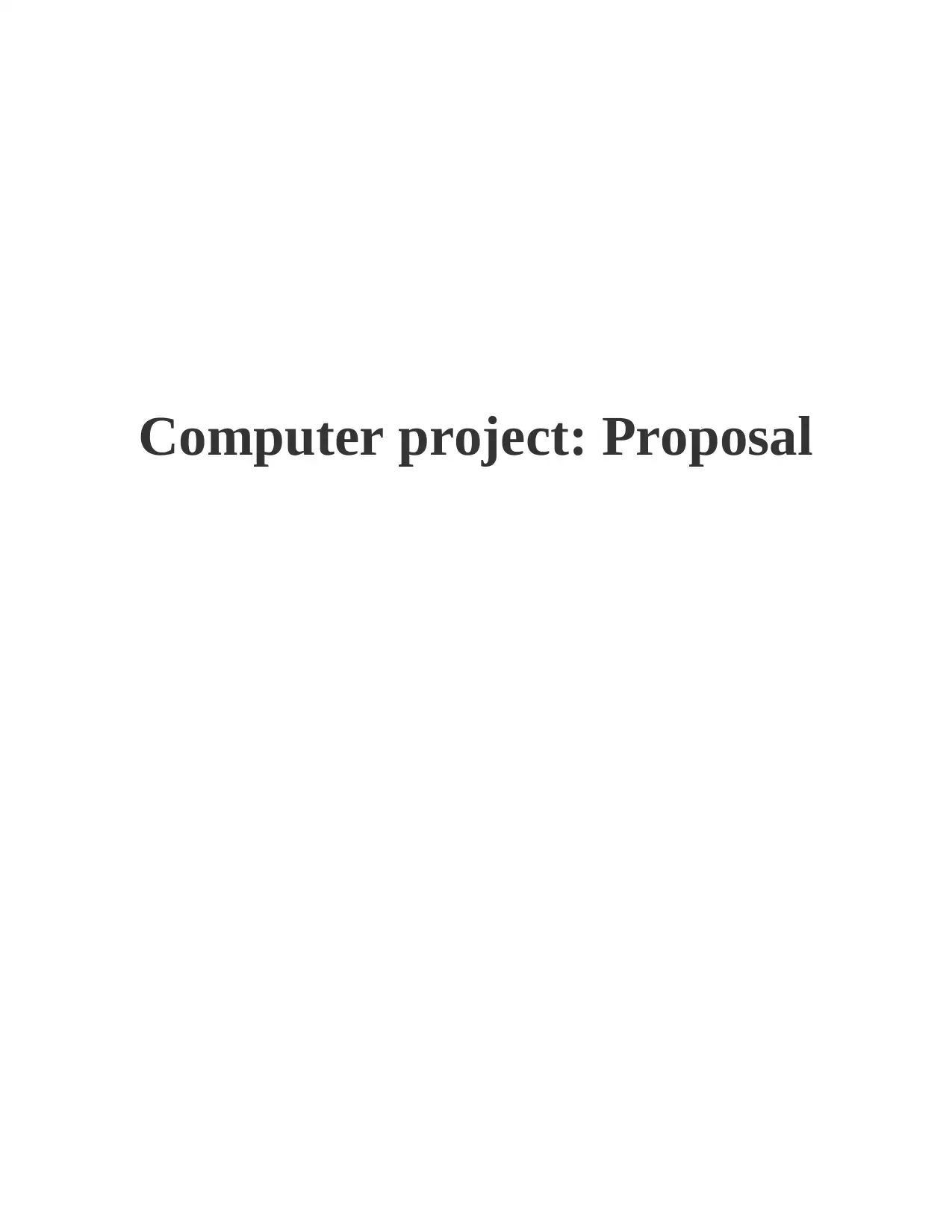
Computer project: Proposal
Paraphrase This Document
Need a fresh take? Get an instant paraphrase of this document with our AI Paraphraser
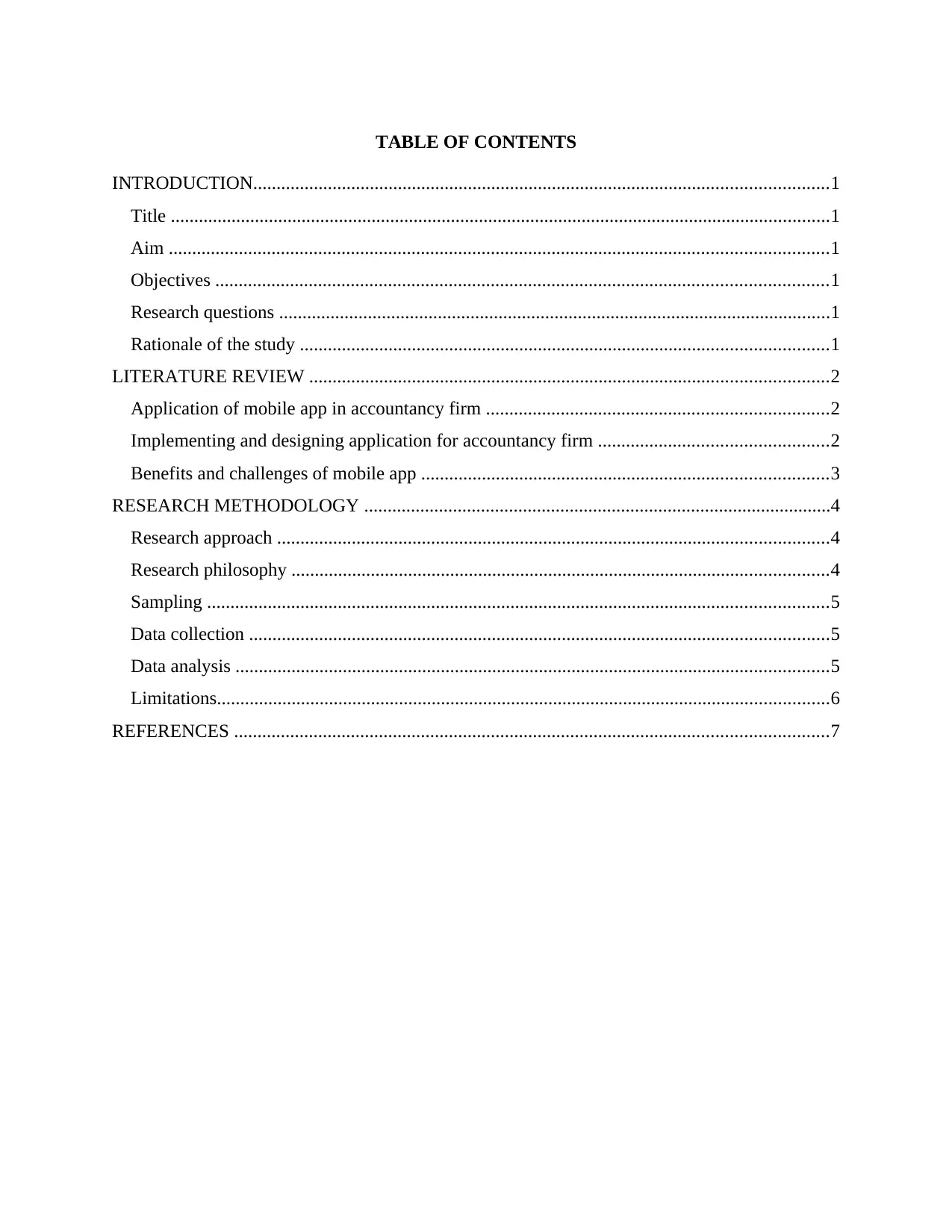
TABLE OF CONTENTS
INTRODUCTION...........................................................................................................................1
Title .............................................................................................................................................1
Aim .............................................................................................................................................1
Objectives ...................................................................................................................................1
Research questions ......................................................................................................................1
Rationale of the study .................................................................................................................1
LITERATURE REVIEW ...............................................................................................................2
Application of mobile app in accountancy firm .........................................................................2
Implementing and designing application for accountancy firm .................................................2
Benefits and challenges of mobile app .......................................................................................3
RESEARCH METHODOLOGY ....................................................................................................4
Research approach ......................................................................................................................4
Research philosophy ...................................................................................................................4
Sampling .....................................................................................................................................5
Data collection ............................................................................................................................5
Data analysis ...............................................................................................................................5
Limitations...................................................................................................................................6
REFERENCES ...............................................................................................................................7
INTRODUCTION...........................................................................................................................1
Title .............................................................................................................................................1
Aim .............................................................................................................................................1
Objectives ...................................................................................................................................1
Research questions ......................................................................................................................1
Rationale of the study .................................................................................................................1
LITERATURE REVIEW ...............................................................................................................2
Application of mobile app in accountancy firm .........................................................................2
Implementing and designing application for accountancy firm .................................................2
Benefits and challenges of mobile app .......................................................................................3
RESEARCH METHODOLOGY ....................................................................................................4
Research approach ......................................................................................................................4
Research philosophy ...................................................................................................................4
Sampling .....................................................................................................................................5
Data collection ............................................................................................................................5
Data analysis ...............................................................................................................................5
Limitations...................................................................................................................................6
REFERENCES ...............................................................................................................................7
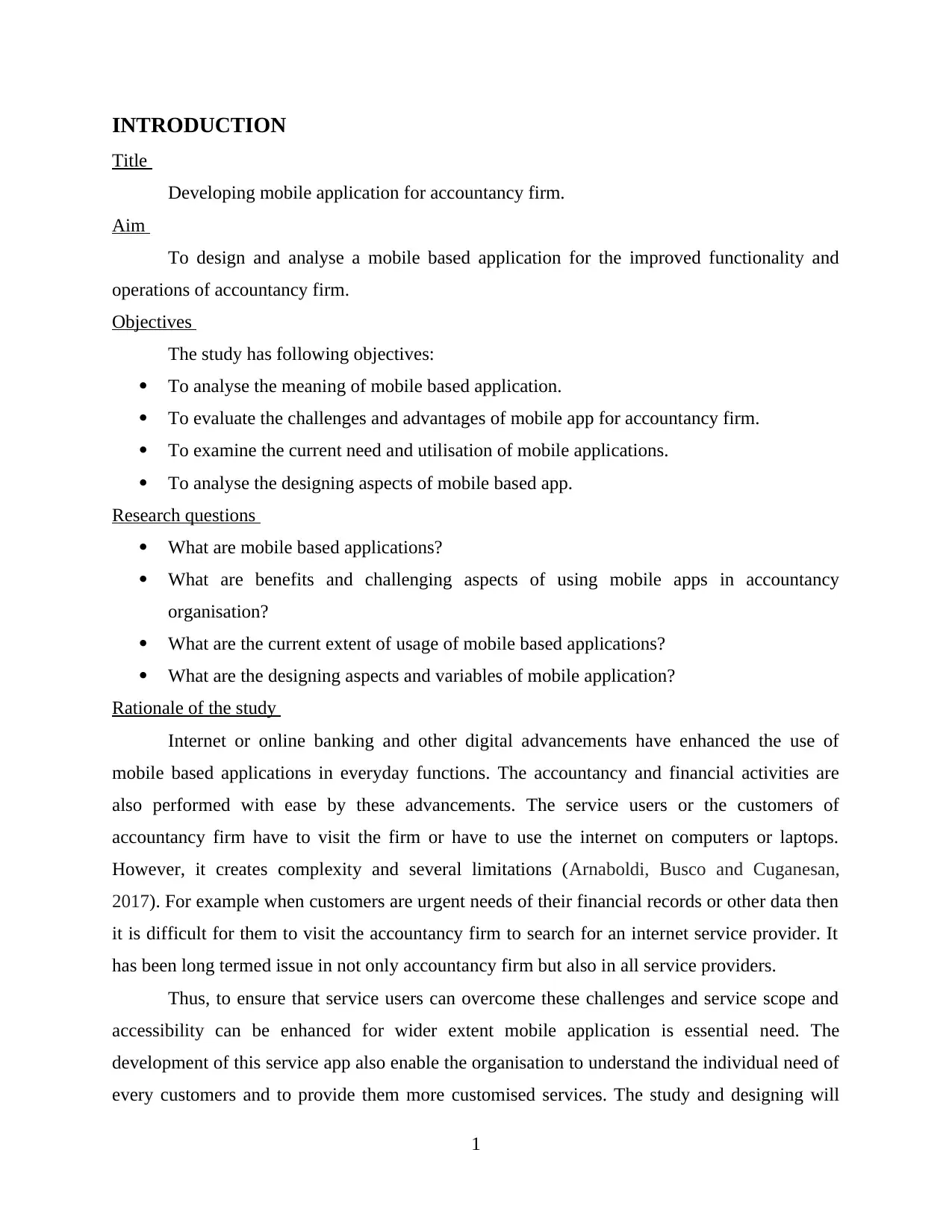
INTRODUCTION
Title
Developing mobile application for accountancy firm.
Aim
To design and analyse a mobile based application for the improved functionality and
operations of accountancy firm.
Objectives
The study has following objectives:
To analyse the meaning of mobile based application.
To evaluate the challenges and advantages of mobile app for accountancy firm.
To examine the current need and utilisation of mobile applications.
To analyse the designing aspects of mobile based app.
Research questions
What are mobile based applications?
What are benefits and challenging aspects of using mobile apps in accountancy
organisation?
What are the current extent of usage of mobile based applications?
What are the designing aspects and variables of mobile application?
Rationale of the study
Internet or online banking and other digital advancements have enhanced the use of
mobile based applications in everyday functions. The accountancy and financial activities are
also performed with ease by these advancements. The service users or the customers of
accountancy firm have to visit the firm or have to use the internet on computers or laptops.
However, it creates complexity and several limitations (Arnaboldi, Busco and Cuganesan,
2017). For example when customers are urgent needs of their financial records or other data then
it is difficult for them to visit the accountancy firm to search for an internet service provider. It
has been long termed issue in not only accountancy firm but also in all service providers.
Thus, to ensure that service users can overcome these challenges and service scope and
accessibility can be enhanced for wider extent mobile application is essential need. The
development of this service app also enable the organisation to understand the individual need of
every customers and to provide them more customised services. The study and designing will
1
Title
Developing mobile application for accountancy firm.
Aim
To design and analyse a mobile based application for the improved functionality and
operations of accountancy firm.
Objectives
The study has following objectives:
To analyse the meaning of mobile based application.
To evaluate the challenges and advantages of mobile app for accountancy firm.
To examine the current need and utilisation of mobile applications.
To analyse the designing aspects of mobile based app.
Research questions
What are mobile based applications?
What are benefits and challenging aspects of using mobile apps in accountancy
organisation?
What are the current extent of usage of mobile based applications?
What are the designing aspects and variables of mobile application?
Rationale of the study
Internet or online banking and other digital advancements have enhanced the use of
mobile based applications in everyday functions. The accountancy and financial activities are
also performed with ease by these advancements. The service users or the customers of
accountancy firm have to visit the firm or have to use the internet on computers or laptops.
However, it creates complexity and several limitations (Arnaboldi, Busco and Cuganesan,
2017). For example when customers are urgent needs of their financial records or other data then
it is difficult for them to visit the accountancy firm to search for an internet service provider. It
has been long termed issue in not only accountancy firm but also in all service providers.
Thus, to ensure that service users can overcome these challenges and service scope and
accessibility can be enhanced for wider extent mobile application is essential need. The
development of this service app also enable the organisation to understand the individual need of
every customers and to provide them more customised services. The study and designing will
1
⊘ This is a preview!⊘
Do you want full access?
Subscribe today to unlock all pages.

Trusted by 1+ million students worldwide
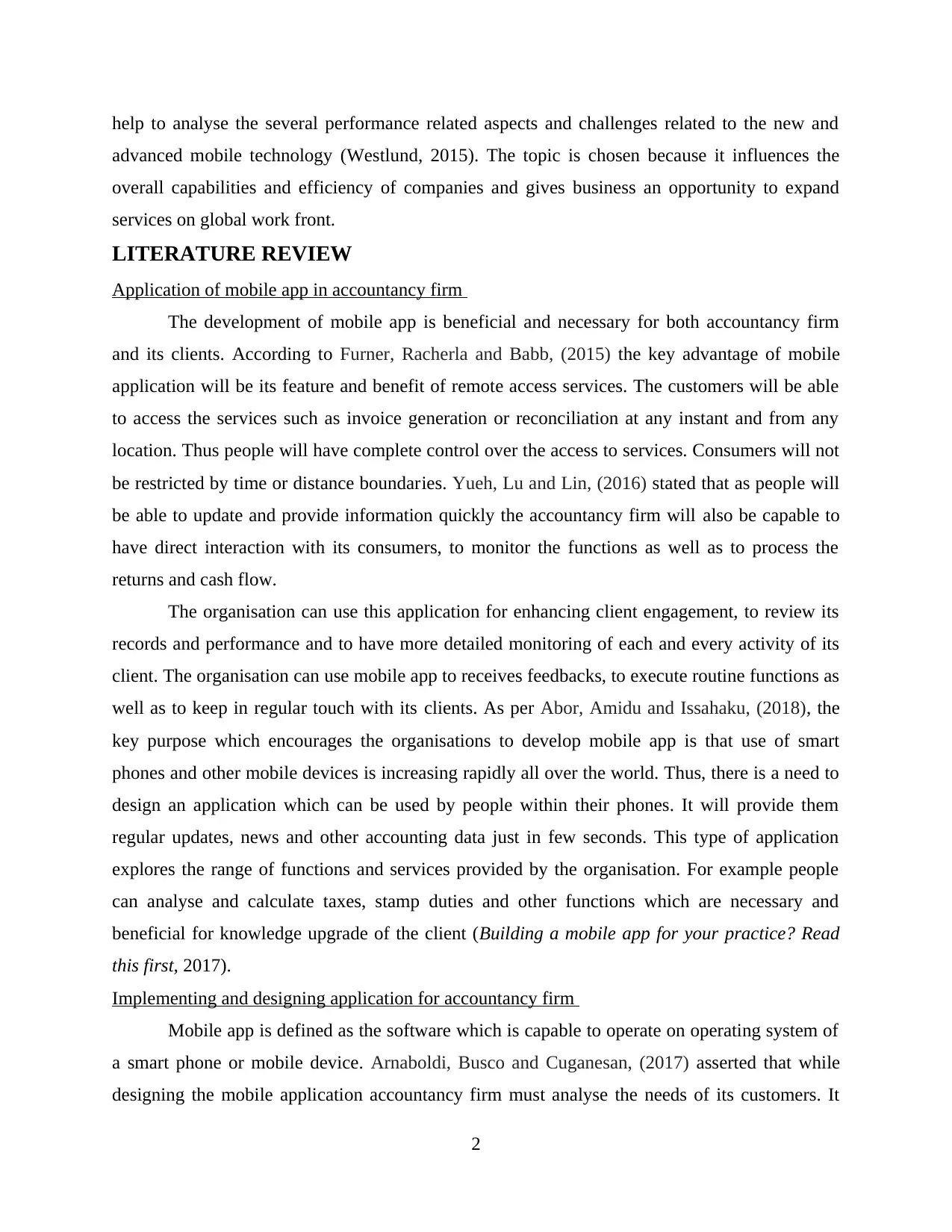
help to analyse the several performance related aspects and challenges related to the new and
advanced mobile technology (Westlund, 2015). The topic is chosen because it influences the
overall capabilities and efficiency of companies and gives business an opportunity to expand
services on global work front.
LITERATURE REVIEW
Application of mobile app in accountancy firm
The development of mobile app is beneficial and necessary for both accountancy firm
and its clients. According to Furner, Racherla and Babb, (2015) the key advantage of mobile
application will be its feature and benefit of remote access services. The customers will be able
to access the services such as invoice generation or reconciliation at any instant and from any
location. Thus people will have complete control over the access to services. Consumers will not
be restricted by time or distance boundaries. Yueh, Lu and Lin, (2016) stated that as people will
be able to update and provide information quickly the accountancy firm will also be capable to
have direct interaction with its consumers, to monitor the functions as well as to process the
returns and cash flow.
The organisation can use this application for enhancing client engagement, to review its
records and performance and to have more detailed monitoring of each and every activity of its
client. The organisation can use mobile app to receives feedbacks, to execute routine functions as
well as to keep in regular touch with its clients. As per Abor, Amidu and Issahaku, (2018), the
key purpose which encourages the organisations to develop mobile app is that use of smart
phones and other mobile devices is increasing rapidly all over the world. Thus, there is a need to
design an application which can be used by people within their phones. It will provide them
regular updates, news and other accounting data just in few seconds. This type of application
explores the range of functions and services provided by the organisation. For example people
can analyse and calculate taxes, stamp duties and other functions which are necessary and
beneficial for knowledge upgrade of the client (Building a mobile app for your practice? Read
this first, 2017).
Implementing and designing application for accountancy firm
Mobile app is defined as the software which is capable to operate on operating system of
a smart phone or mobile device. Arnaboldi, Busco and Cuganesan, (2017) asserted that while
designing the mobile application accountancy firm must analyse the needs of its customers. It
2
advanced mobile technology (Westlund, 2015). The topic is chosen because it influences the
overall capabilities and efficiency of companies and gives business an opportunity to expand
services on global work front.
LITERATURE REVIEW
Application of mobile app in accountancy firm
The development of mobile app is beneficial and necessary for both accountancy firm
and its clients. According to Furner, Racherla and Babb, (2015) the key advantage of mobile
application will be its feature and benefit of remote access services. The customers will be able
to access the services such as invoice generation or reconciliation at any instant and from any
location. Thus people will have complete control over the access to services. Consumers will not
be restricted by time or distance boundaries. Yueh, Lu and Lin, (2016) stated that as people will
be able to update and provide information quickly the accountancy firm will also be capable to
have direct interaction with its consumers, to monitor the functions as well as to process the
returns and cash flow.
The organisation can use this application for enhancing client engagement, to review its
records and performance and to have more detailed monitoring of each and every activity of its
client. The organisation can use mobile app to receives feedbacks, to execute routine functions as
well as to keep in regular touch with its clients. As per Abor, Amidu and Issahaku, (2018), the
key purpose which encourages the organisations to develop mobile app is that use of smart
phones and other mobile devices is increasing rapidly all over the world. Thus, there is a need to
design an application which can be used by people within their phones. It will provide them
regular updates, news and other accounting data just in few seconds. This type of application
explores the range of functions and services provided by the organisation. For example people
can analyse and calculate taxes, stamp duties and other functions which are necessary and
beneficial for knowledge upgrade of the client (Building a mobile app for your practice? Read
this first, 2017).
Implementing and designing application for accountancy firm
Mobile app is defined as the software which is capable to operate on operating system of
a smart phone or mobile device. Arnaboldi, Busco and Cuganesan, (2017) asserted that while
designing the mobile application accountancy firm must analyse the needs of its customers. It
2
Paraphrase This Document
Need a fresh take? Get an instant paraphrase of this document with our AI Paraphraser
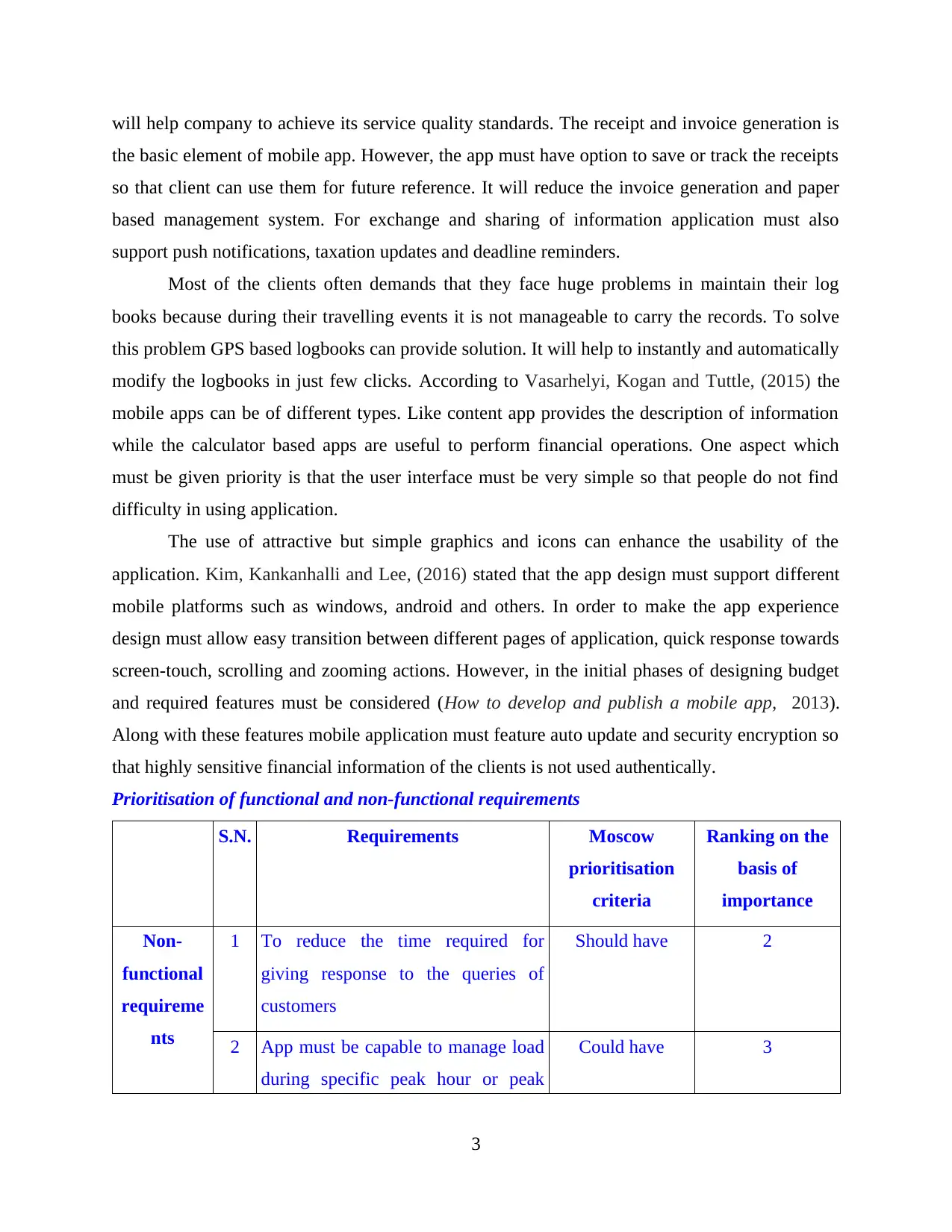
will help company to achieve its service quality standards. The receipt and invoice generation is
the basic element of mobile app. However, the app must have option to save or track the receipts
so that client can use them for future reference. It will reduce the invoice generation and paper
based management system. For exchange and sharing of information application must also
support push notifications, taxation updates and deadline reminders.
Most of the clients often demands that they face huge problems in maintain their log
books because during their travelling events it is not manageable to carry the records. To solve
this problem GPS based logbooks can provide solution. It will help to instantly and automatically
modify the logbooks in just few clicks. According to Vasarhelyi, Kogan and Tuttle, (2015) the
mobile apps can be of different types. Like content app provides the description of information
while the calculator based apps are useful to perform financial operations. One aspect which
must be given priority is that the user interface must be very simple so that people do not find
difficulty in using application.
The use of attractive but simple graphics and icons can enhance the usability of the
application. Kim, Kankanhalli and Lee, (2016) stated that the app design must support different
mobile platforms such as windows, android and others. In order to make the app experience
design must allow easy transition between different pages of application, quick response towards
screen-touch, scrolling and zooming actions. However, in the initial phases of designing budget
and required features must be considered (How to develop and publish a mobile app, 2013).
Along with these features mobile application must feature auto update and security encryption so
that highly sensitive financial information of the clients is not used authentically.
Prioritisation of functional and non-functional requirements
S.N. Requirements Moscow
prioritisation
criteria
Ranking on the
basis of
importance
Non-
functional
requireme
nts
1 To reduce the time required for
giving response to the queries of
customers
Should have 2
2 App must be capable to manage load
during specific peak hour or peak
Could have 3
3
the basic element of mobile app. However, the app must have option to save or track the receipts
so that client can use them for future reference. It will reduce the invoice generation and paper
based management system. For exchange and sharing of information application must also
support push notifications, taxation updates and deadline reminders.
Most of the clients often demands that they face huge problems in maintain their log
books because during their travelling events it is not manageable to carry the records. To solve
this problem GPS based logbooks can provide solution. It will help to instantly and automatically
modify the logbooks in just few clicks. According to Vasarhelyi, Kogan and Tuttle, (2015) the
mobile apps can be of different types. Like content app provides the description of information
while the calculator based apps are useful to perform financial operations. One aspect which
must be given priority is that the user interface must be very simple so that people do not find
difficulty in using application.
The use of attractive but simple graphics and icons can enhance the usability of the
application. Kim, Kankanhalli and Lee, (2016) stated that the app design must support different
mobile platforms such as windows, android and others. In order to make the app experience
design must allow easy transition between different pages of application, quick response towards
screen-touch, scrolling and zooming actions. However, in the initial phases of designing budget
and required features must be considered (How to develop and publish a mobile app, 2013).
Along with these features mobile application must feature auto update and security encryption so
that highly sensitive financial information of the clients is not used authentically.
Prioritisation of functional and non-functional requirements
S.N. Requirements Moscow
prioritisation
criteria
Ranking on the
basis of
importance
Non-
functional
requireme
nts
1 To reduce the time required for
giving response to the queries of
customers
Should have 2
2 App must be capable to manage load
during specific peak hour or peak
Could have 3
3
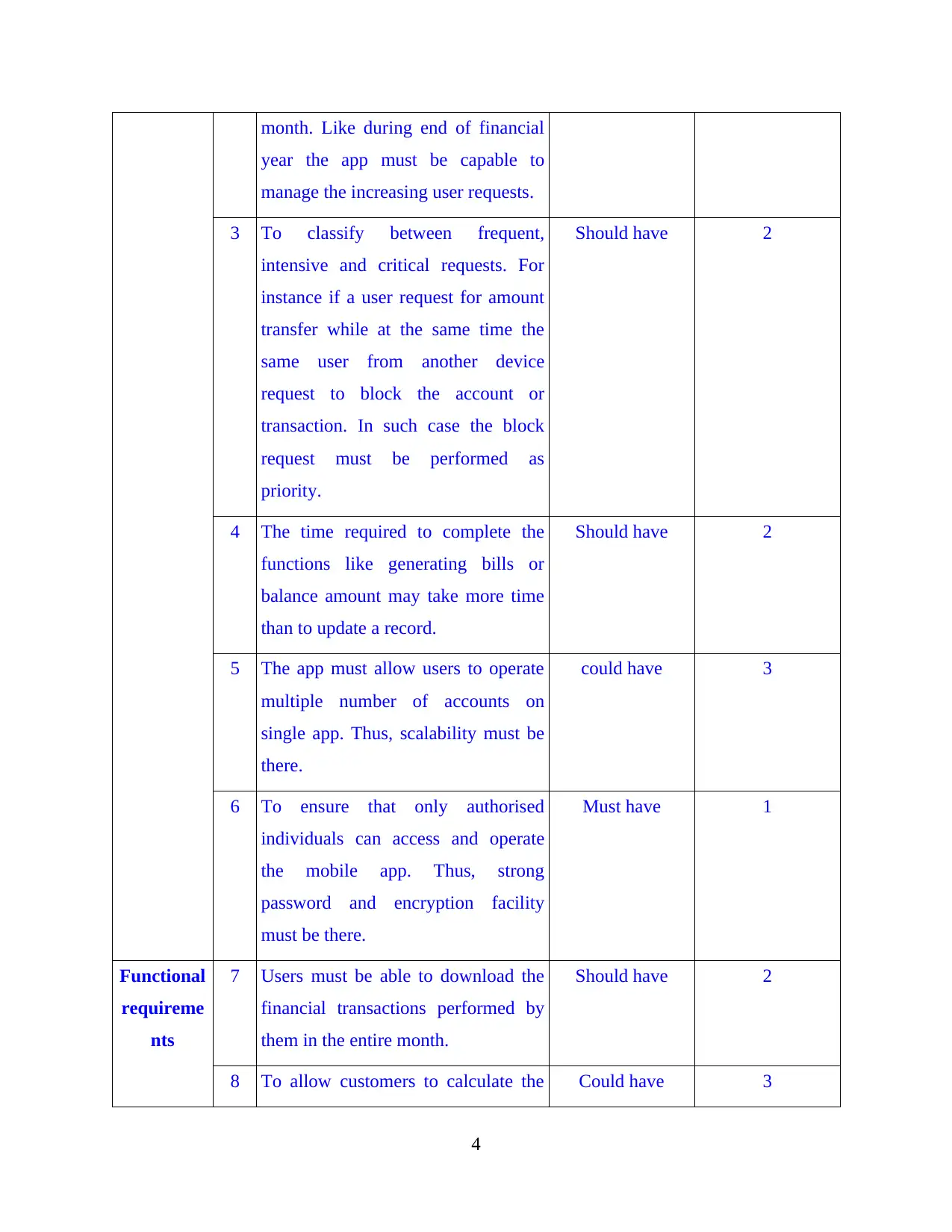
month. Like during end of financial
year the app must be capable to
manage the increasing user requests.
3 To classify between frequent,
intensive and critical requests. For
instance if a user request for amount
transfer while at the same time the
same user from another device
request to block the account or
transaction. In such case the block
request must be performed as
priority.
Should have 2
4 The time required to complete the
functions like generating bills or
balance amount may take more time
than to update a record.
Should have 2
5 The app must allow users to operate
multiple number of accounts on
single app. Thus, scalability must be
there.
could have 3
6 To ensure that only authorised
individuals can access and operate
the mobile app. Thus, strong
password and encryption facility
must be there.
Must have 1
Functional
requireme
nts
7 Users must be able to download the
financial transactions performed by
them in the entire month.
Should have 2
8 To allow customers to calculate the Could have 3
4
year the app must be capable to
manage the increasing user requests.
3 To classify between frequent,
intensive and critical requests. For
instance if a user request for amount
transfer while at the same time the
same user from another device
request to block the account or
transaction. In such case the block
request must be performed as
priority.
Should have 2
4 The time required to complete the
functions like generating bills or
balance amount may take more time
than to update a record.
Should have 2
5 The app must allow users to operate
multiple number of accounts on
single app. Thus, scalability must be
there.
could have 3
6 To ensure that only authorised
individuals can access and operate
the mobile app. Thus, strong
password and encryption facility
must be there.
Must have 1
Functional
requireme
nts
7 Users must be able to download the
financial transactions performed by
them in the entire month.
Should have 2
8 To allow customers to calculate the Could have 3
4
⊘ This is a preview!⊘
Do you want full access?
Subscribe today to unlock all pages.

Trusted by 1+ million students worldwide
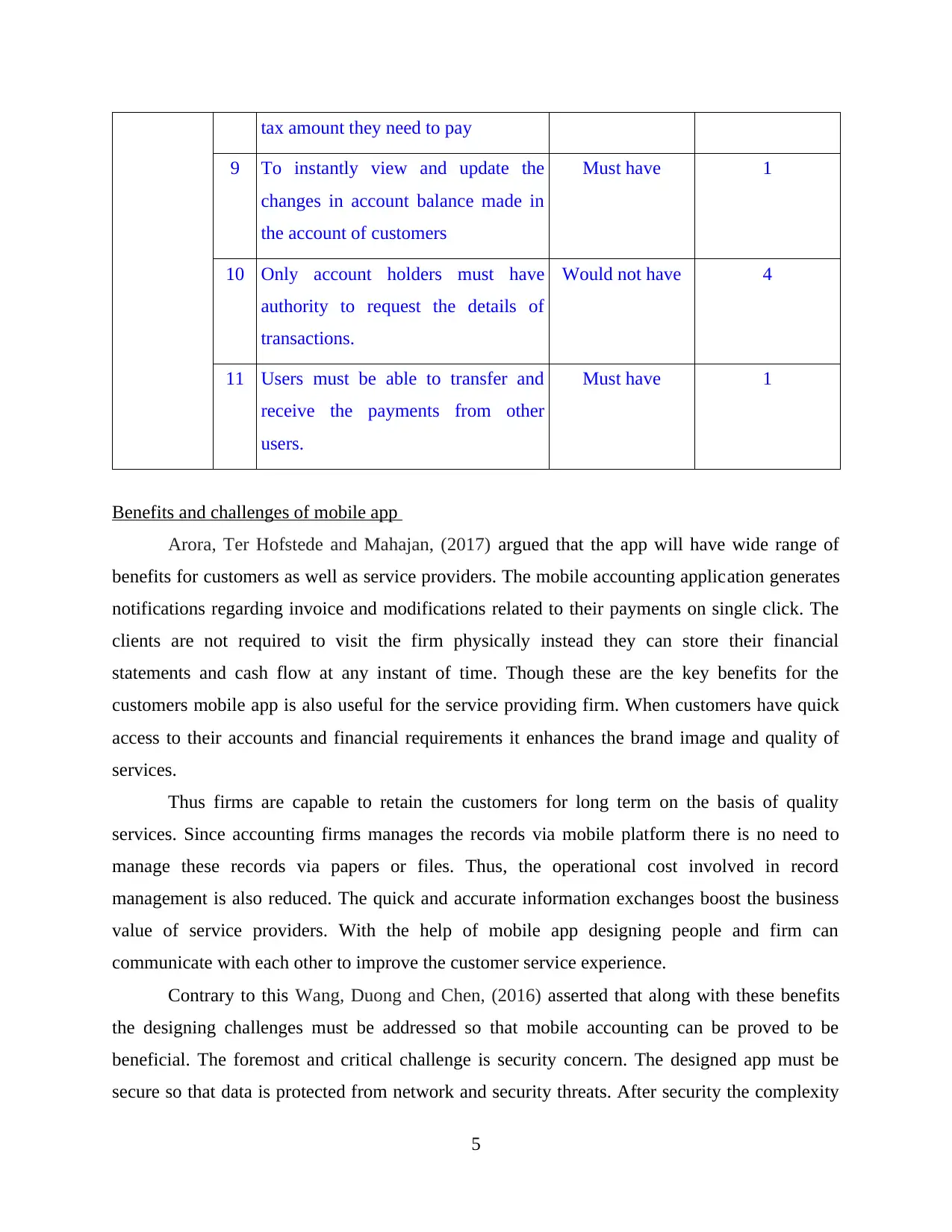
tax amount they need to pay
9 To instantly view and update the
changes in account balance made in
the account of customers
Must have 1
10 Only account holders must have
authority to request the details of
transactions.
Would not have 4
11 Users must be able to transfer and
receive the payments from other
users.
Must have 1
Benefits and challenges of mobile app
Arora, Ter Hofstede and Mahajan, (2017) argued that the app will have wide range of
benefits for customers as well as service providers. The mobile accounting application generates
notifications regarding invoice and modifications related to their payments on single click. The
clients are not required to visit the firm physically instead they can store their financial
statements and cash flow at any instant of time. Though these are the key benefits for the
customers mobile app is also useful for the service providing firm. When customers have quick
access to their accounts and financial requirements it enhances the brand image and quality of
services.
Thus firms are capable to retain the customers for long term on the basis of quality
services. Since accounting firms manages the records via mobile platform there is no need to
manage these records via papers or files. Thus, the operational cost involved in record
management is also reduced. The quick and accurate information exchanges boost the business
value of service providers. With the help of mobile app designing people and firm can
communicate with each other to improve the customer service experience.
Contrary to this Wang, Duong and Chen, (2016) asserted that along with these benefits
the designing challenges must be addressed so that mobile accounting can be proved to be
beneficial. The foremost and critical challenge is security concern. The designed app must be
secure so that data is protected from network and security threats. After security the complexity
5
9 To instantly view and update the
changes in account balance made in
the account of customers
Must have 1
10 Only account holders must have
authority to request the details of
transactions.
Would not have 4
11 Users must be able to transfer and
receive the payments from other
users.
Must have 1
Benefits and challenges of mobile app
Arora, Ter Hofstede and Mahajan, (2017) argued that the app will have wide range of
benefits for customers as well as service providers. The mobile accounting application generates
notifications regarding invoice and modifications related to their payments on single click. The
clients are not required to visit the firm physically instead they can store their financial
statements and cash flow at any instant of time. Though these are the key benefits for the
customers mobile app is also useful for the service providing firm. When customers have quick
access to their accounts and financial requirements it enhances the brand image and quality of
services.
Thus firms are capable to retain the customers for long term on the basis of quality
services. Since accounting firms manages the records via mobile platform there is no need to
manage these records via papers or files. Thus, the operational cost involved in record
management is also reduced. The quick and accurate information exchanges boost the business
value of service providers. With the help of mobile app designing people and firm can
communicate with each other to improve the customer service experience.
Contrary to this Wang, Duong and Chen, (2016) asserted that along with these benefits
the designing challenges must be addressed so that mobile accounting can be proved to be
beneficial. The foremost and critical challenge is security concern. The designed app must be
secure so that data is protected from network and security threats. After security the complexity
5
Paraphrase This Document
Need a fresh take? Get an instant paraphrase of this document with our AI Paraphraser

of user interface must be minimum otherwise people will not prefer the use of application. It is
also possible that app is not designed as per the needs of customers thus before making final
design it must be reviewed to assure that it will be profitable for the customers.
RESEARCH METHODOLOGY
Research approach
Research approaches are simple plans or procedures that consist of different data
collection methods, interpretation etc. it is typically divided into three types which are:
deductive, inductive and abduction research approach. For this qualitative research proposal
inductive research will be used. It is also known as inductive reasoning as it states with theories
and observations that are proposed at the end of research process for observations. It is simply
used for untested conclusions for simple theory generation and building. It follows a simple
pattern which is first all the observations are tested then on the basis of those observations a
simple pattern is created and then based on those pattens a theory is created (Rahi, 2017).
Research philosophy
It is used to understand the way research is carried out by understanding all the elements
of the research. It is of four types which are pragmatism, interpretivism, positivism and realism
research philosophy. In this research proposal interpretivism research philosophy is used which
uses primary data collection method. Interpretivism is also known as interpritivist that uses small
sample of primary data where investigation, interviews, questionnaires are made for all the
qualitative primary data. In this interpretivism research philosophy secondary research is also
concluded however it is not much popular. Nature of this philosophy is constructed socially with
an ultimate goal of understanding weak predictions. Relationship of subject and researcher in this
is cooperative, interactive and participative.
Sampling
Sampling is a normal principle which is normally used to select members of a population
that are included in the study. It makes it easy for the researcher to reach to the conclusion and
increases the accuracy of primary data. It also helps in finding more accurate data for research
findings so that it can be processed efficiently. It is mainly of two types i.e. probability and non
probability sampling which are further divided into many types. For this research probability
sampling will be used. Probability is a type of sampling in which all the members of population
participate. It is further of four types which are: simple random, systematic random, stratified
6
also possible that app is not designed as per the needs of customers thus before making final
design it must be reviewed to assure that it will be profitable for the customers.
RESEARCH METHODOLOGY
Research approach
Research approaches are simple plans or procedures that consist of different data
collection methods, interpretation etc. it is typically divided into three types which are:
deductive, inductive and abduction research approach. For this qualitative research proposal
inductive research will be used. It is also known as inductive reasoning as it states with theories
and observations that are proposed at the end of research process for observations. It is simply
used for untested conclusions for simple theory generation and building. It follows a simple
pattern which is first all the observations are tested then on the basis of those observations a
simple pattern is created and then based on those pattens a theory is created (Rahi, 2017).
Research philosophy
It is used to understand the way research is carried out by understanding all the elements
of the research. It is of four types which are pragmatism, interpretivism, positivism and realism
research philosophy. In this research proposal interpretivism research philosophy is used which
uses primary data collection method. Interpretivism is also known as interpritivist that uses small
sample of primary data where investigation, interviews, questionnaires are made for all the
qualitative primary data. In this interpretivism research philosophy secondary research is also
concluded however it is not much popular. Nature of this philosophy is constructed socially with
an ultimate goal of understanding weak predictions. Relationship of subject and researcher in this
is cooperative, interactive and participative.
Sampling
Sampling is a normal principle which is normally used to select members of a population
that are included in the study. It makes it easy for the researcher to reach to the conclusion and
increases the accuracy of primary data. It also helps in finding more accurate data for research
findings so that it can be processed efficiently. It is mainly of two types i.e. probability and non
probability sampling which are further divided into many types. For this research probability
sampling will be used. Probability is a type of sampling in which all the members of population
participate. It is further of four types which are: simple random, systematic random, stratified
6
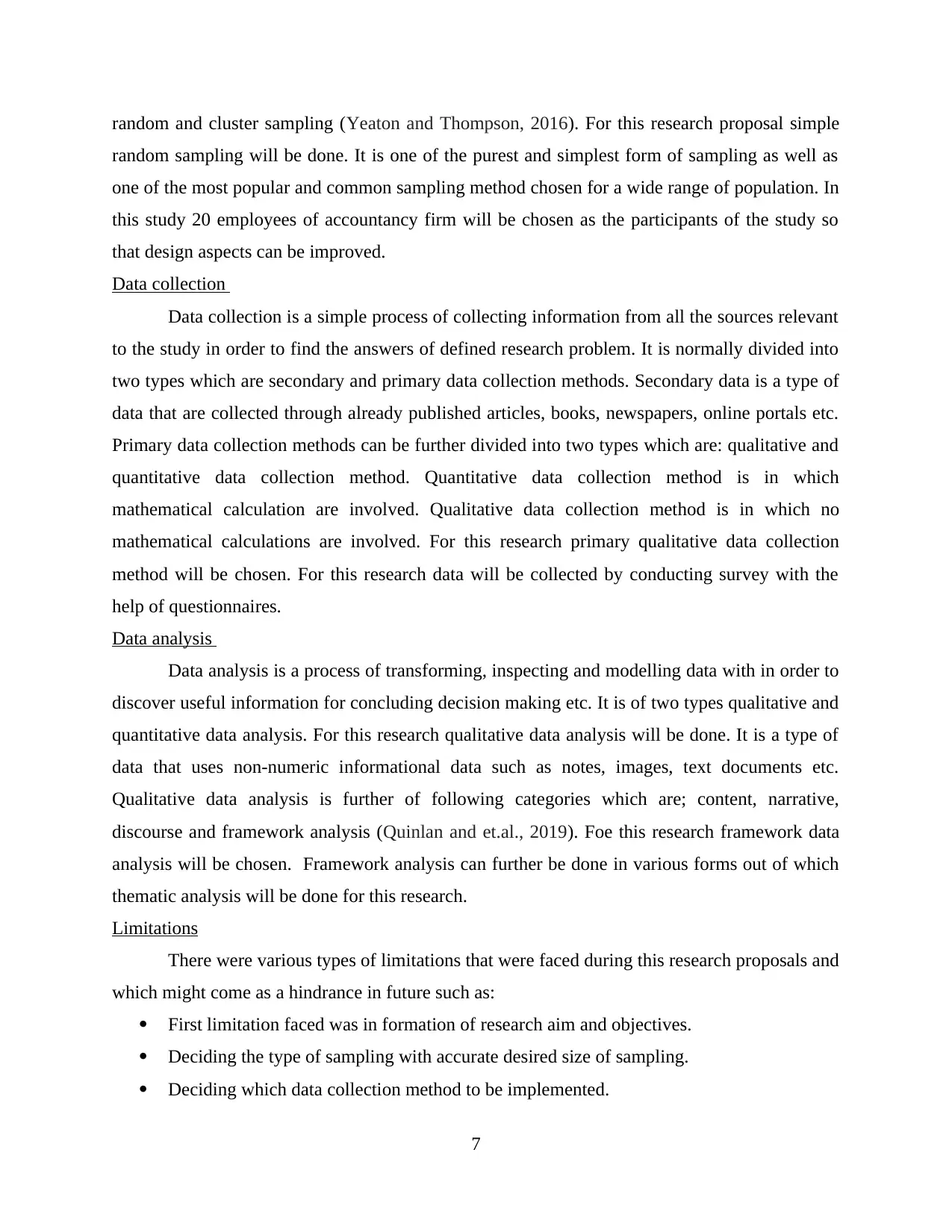
random and cluster sampling (Yeaton and Thompson, 2016). For this research proposal simple
random sampling will be done. It is one of the purest and simplest form of sampling as well as
one of the most popular and common sampling method chosen for a wide range of population. In
this study 20 employees of accountancy firm will be chosen as the participants of the study so
that design aspects can be improved.
Data collection
Data collection is a simple process of collecting information from all the sources relevant
to the study in order to find the answers of defined research problem. It is normally divided into
two types which are secondary and primary data collection methods. Secondary data is a type of
data that are collected through already published articles, books, newspapers, online portals etc.
Primary data collection methods can be further divided into two types which are: qualitative and
quantitative data collection method. Quantitative data collection method is in which
mathematical calculation are involved. Qualitative data collection method is in which no
mathematical calculations are involved. For this research primary qualitative data collection
method will be chosen. For this research data will be collected by conducting survey with the
help of questionnaires.
Data analysis
Data analysis is a process of transforming, inspecting and modelling data with in order to
discover useful information for concluding decision making etc. It is of two types qualitative and
quantitative data analysis. For this research qualitative data analysis will be done. It is a type of
data that uses non-numeric informational data such as notes, images, text documents etc.
Qualitative data analysis is further of following categories which are; content, narrative,
discourse and framework analysis (Quinlan and et.al., 2019). Foe this research framework data
analysis will be chosen. Framework analysis can further be done in various forms out of which
thematic analysis will be done for this research.
Limitations
There were various types of limitations that were faced during this research proposals and
which might come as a hindrance in future such as:
First limitation faced was in formation of research aim and objectives.
Deciding the type of sampling with accurate desired size of sampling.
Deciding which data collection method to be implemented.
7
random sampling will be done. It is one of the purest and simplest form of sampling as well as
one of the most popular and common sampling method chosen for a wide range of population. In
this study 20 employees of accountancy firm will be chosen as the participants of the study so
that design aspects can be improved.
Data collection
Data collection is a simple process of collecting information from all the sources relevant
to the study in order to find the answers of defined research problem. It is normally divided into
two types which are secondary and primary data collection methods. Secondary data is a type of
data that are collected through already published articles, books, newspapers, online portals etc.
Primary data collection methods can be further divided into two types which are: qualitative and
quantitative data collection method. Quantitative data collection method is in which
mathematical calculation are involved. Qualitative data collection method is in which no
mathematical calculations are involved. For this research primary qualitative data collection
method will be chosen. For this research data will be collected by conducting survey with the
help of questionnaires.
Data analysis
Data analysis is a process of transforming, inspecting and modelling data with in order to
discover useful information for concluding decision making etc. It is of two types qualitative and
quantitative data analysis. For this research qualitative data analysis will be done. It is a type of
data that uses non-numeric informational data such as notes, images, text documents etc.
Qualitative data analysis is further of following categories which are; content, narrative,
discourse and framework analysis (Quinlan and et.al., 2019). Foe this research framework data
analysis will be chosen. Framework analysis can further be done in various forms out of which
thematic analysis will be done for this research.
Limitations
There were various types of limitations that were faced during this research proposals and
which might come as a hindrance in future such as:
First limitation faced was in formation of research aim and objectives.
Deciding the type of sampling with accurate desired size of sampling.
Deciding which data collection method to be implemented.
7
⊘ This is a preview!⊘
Do you want full access?
Subscribe today to unlock all pages.

Trusted by 1+ million students worldwide
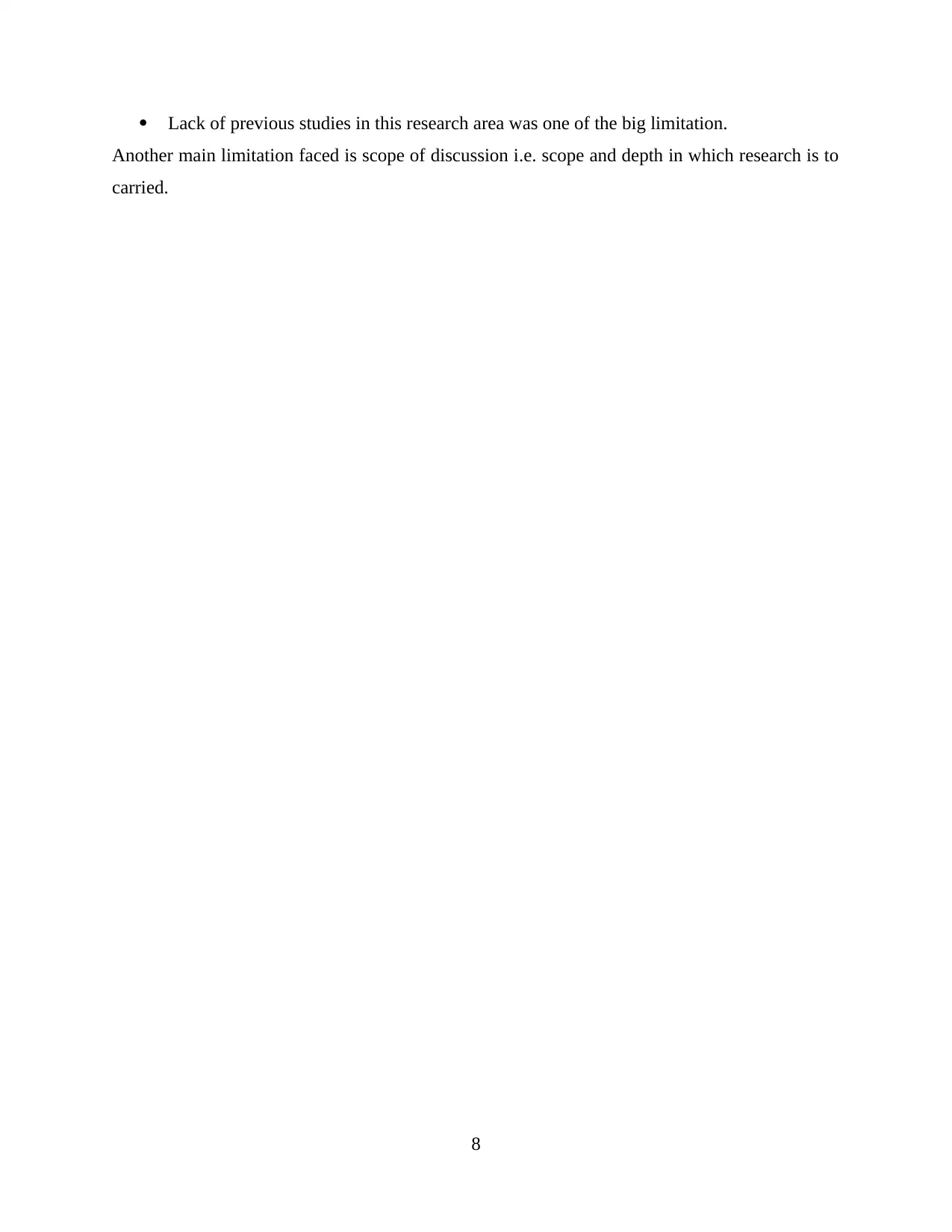
Lack of previous studies in this research area was one of the big limitation.
Another main limitation faced is scope of discussion i.e. scope and depth in which research is to
carried.
8
Another main limitation faced is scope of discussion i.e. scope and depth in which research is to
carried.
8
Paraphrase This Document
Need a fresh take? Get an instant paraphrase of this document with our AI Paraphraser
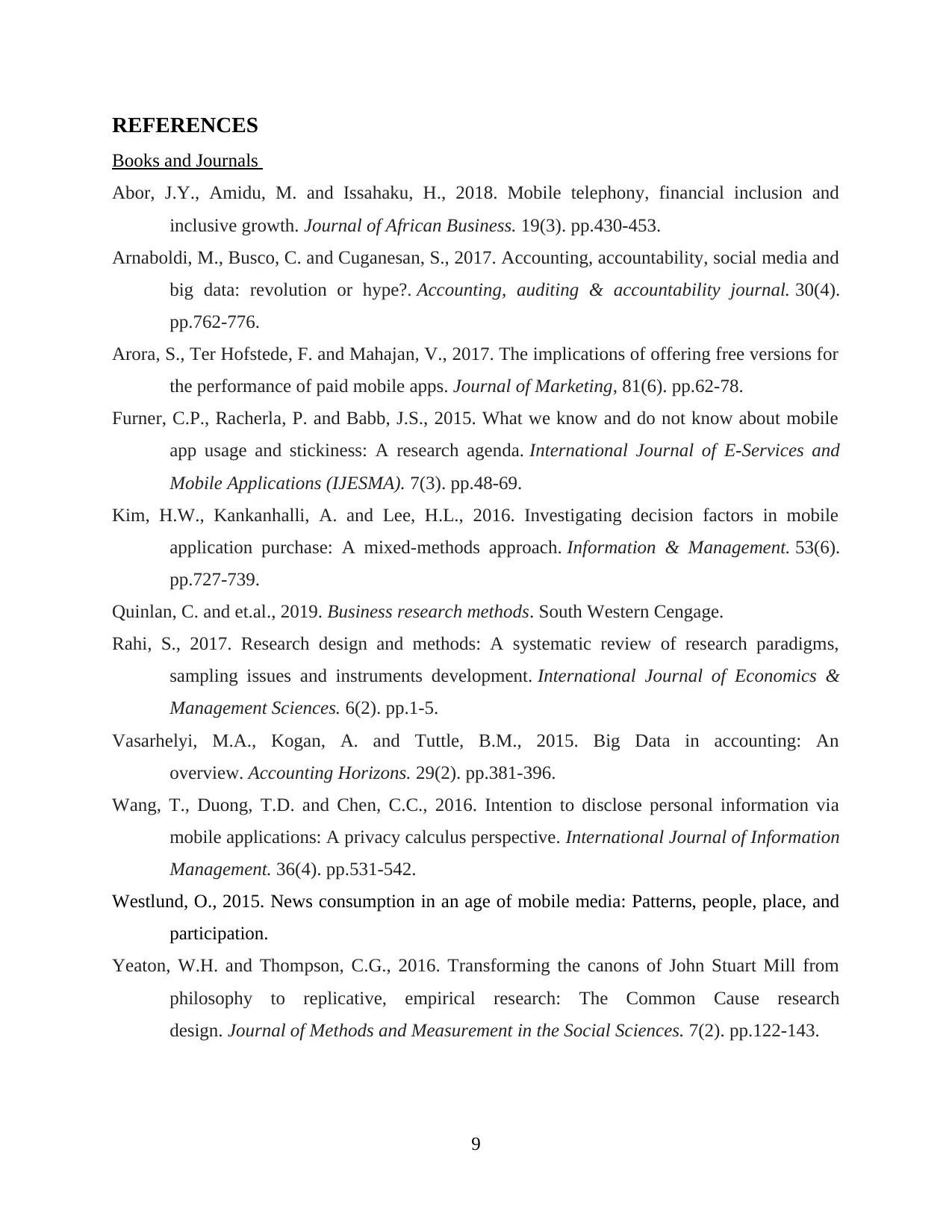
REFERENCES
Books and Journals
Abor, J.Y., Amidu, M. and Issahaku, H., 2018. Mobile telephony, financial inclusion and
inclusive growth. Journal of African Business. 19(3). pp.430-453.
Arnaboldi, M., Busco, C. and Cuganesan, S., 2017. Accounting, accountability, social media and
big data: revolution or hype?. Accounting, auditing & accountability journal. 30(4).
pp.762-776.
Arora, S., Ter Hofstede, F. and Mahajan, V., 2017. The implications of offering free versions for
the performance of paid mobile apps. Journal of Marketing, 81(6). pp.62-78.
Furner, C.P., Racherla, P. and Babb, J.S., 2015. What we know and do not know about mobile
app usage and stickiness: A research agenda. International Journal of E-Services and
Mobile Applications (IJESMA). 7(3). pp.48-69.
Kim, H.W., Kankanhalli, A. and Lee, H.L., 2016. Investigating decision factors in mobile
application purchase: A mixed-methods approach. Information & Management. 53(6).
pp.727-739.
Quinlan, C. and et.al., 2019. Business research methods. South Western Cengage.
Rahi, S., 2017. Research design and methods: A systematic review of research paradigms,
sampling issues and instruments development. International Journal of Economics &
Management Sciences. 6(2). pp.1-5.
Vasarhelyi, M.A., Kogan, A. and Tuttle, B.M., 2015. Big Data in accounting: An
overview. Accounting Horizons. 29(2). pp.381-396.
Wang, T., Duong, T.D. and Chen, C.C., 2016. Intention to disclose personal information via
mobile applications: A privacy calculus perspective. International Journal of Information
Management. 36(4). pp.531-542.
Westlund, O., 2015. News consumption in an age of mobile media: Patterns, people, place, and
participation.
Yeaton, W.H. and Thompson, C.G., 2016. Transforming the canons of John Stuart Mill from
philosophy to replicative, empirical research: The Common Cause research
design. Journal of Methods and Measurement in the Social Sciences. 7(2). pp.122-143.
9
Books and Journals
Abor, J.Y., Amidu, M. and Issahaku, H., 2018. Mobile telephony, financial inclusion and
inclusive growth. Journal of African Business. 19(3). pp.430-453.
Arnaboldi, M., Busco, C. and Cuganesan, S., 2017. Accounting, accountability, social media and
big data: revolution or hype?. Accounting, auditing & accountability journal. 30(4).
pp.762-776.
Arora, S., Ter Hofstede, F. and Mahajan, V., 2017. The implications of offering free versions for
the performance of paid mobile apps. Journal of Marketing, 81(6). pp.62-78.
Furner, C.P., Racherla, P. and Babb, J.S., 2015. What we know and do not know about mobile
app usage and stickiness: A research agenda. International Journal of E-Services and
Mobile Applications (IJESMA). 7(3). pp.48-69.
Kim, H.W., Kankanhalli, A. and Lee, H.L., 2016. Investigating decision factors in mobile
application purchase: A mixed-methods approach. Information & Management. 53(6).
pp.727-739.
Quinlan, C. and et.al., 2019. Business research methods. South Western Cengage.
Rahi, S., 2017. Research design and methods: A systematic review of research paradigms,
sampling issues and instruments development. International Journal of Economics &
Management Sciences. 6(2). pp.1-5.
Vasarhelyi, M.A., Kogan, A. and Tuttle, B.M., 2015. Big Data in accounting: An
overview. Accounting Horizons. 29(2). pp.381-396.
Wang, T., Duong, T.D. and Chen, C.C., 2016. Intention to disclose personal information via
mobile applications: A privacy calculus perspective. International Journal of Information
Management. 36(4). pp.531-542.
Westlund, O., 2015. News consumption in an age of mobile media: Patterns, people, place, and
participation.
Yeaton, W.H. and Thompson, C.G., 2016. Transforming the canons of John Stuart Mill from
philosophy to replicative, empirical research: The Common Cause research
design. Journal of Methods and Measurement in the Social Sciences. 7(2). pp.122-143.
9
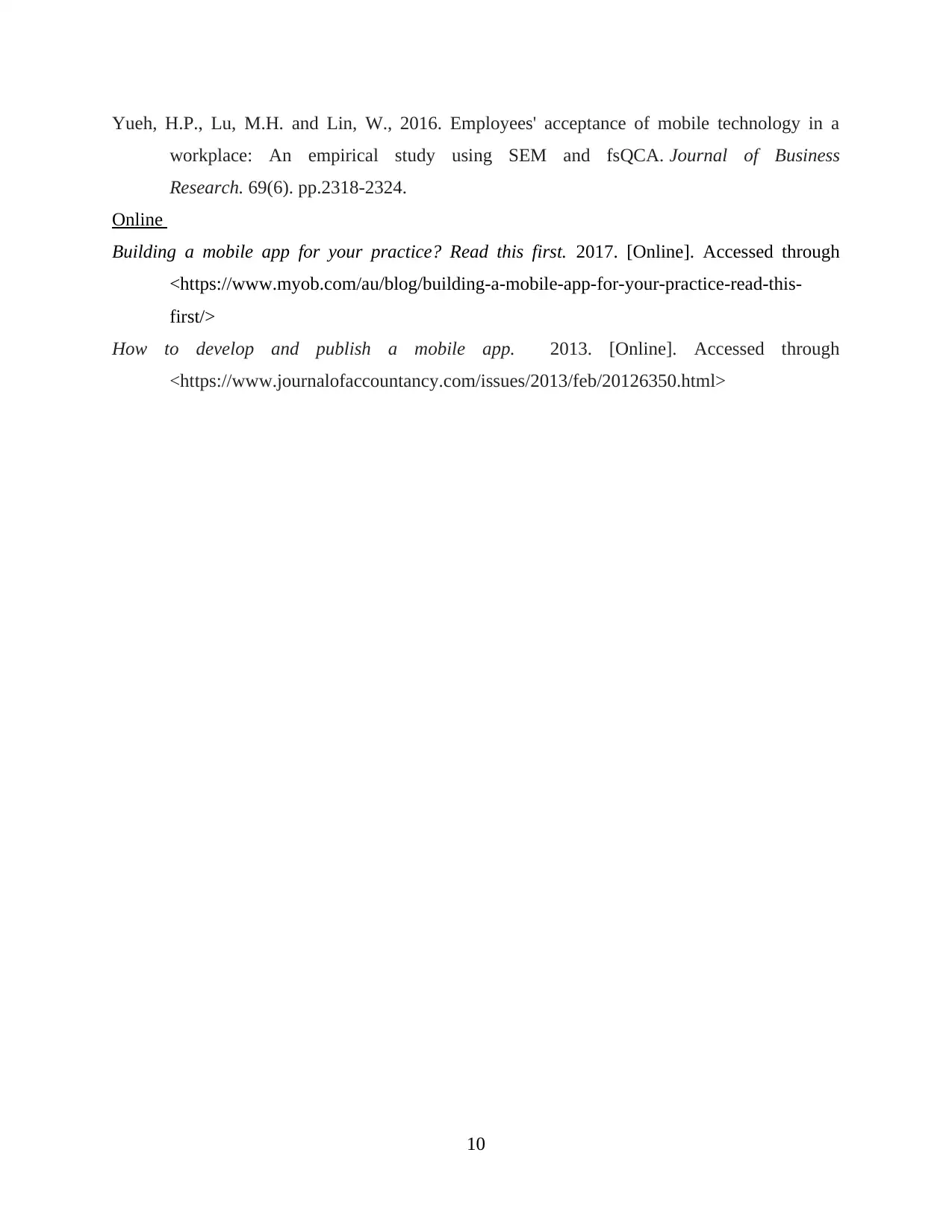
Yueh, H.P., Lu, M.H. and Lin, W., 2016. Employees' acceptance of mobile technology in a
workplace: An empirical study using SEM and fsQCA. Journal of Business
Research. 69(6). pp.2318-2324.
Online
Building a mobile app for your practice? Read this first. 2017. [Online]. Accessed through
<https://www.myob.com/au/blog/building-a-mobile-app-for-your-practice-read-this-
first/>
How to develop and publish a mobile app. 2013. [Online]. Accessed through
<https://www.journalofaccountancy.com/issues/2013/feb/20126350.html>
10
workplace: An empirical study using SEM and fsQCA. Journal of Business
Research. 69(6). pp.2318-2324.
Online
Building a mobile app for your practice? Read this first. 2017. [Online]. Accessed through
<https://www.myob.com/au/blog/building-a-mobile-app-for-your-practice-read-this-
first/>
How to develop and publish a mobile app. 2013. [Online]. Accessed through
<https://www.journalofaccountancy.com/issues/2013/feb/20126350.html>
10
⊘ This is a preview!⊘
Do you want full access?
Subscribe today to unlock all pages.

Trusted by 1+ million students worldwide
1 out of 17
Related Documents
Your All-in-One AI-Powered Toolkit for Academic Success.
+13062052269
info@desklib.com
Available 24*7 on WhatsApp / Email
![[object Object]](/_next/static/media/star-bottom.7253800d.svg)
Unlock your academic potential
Copyright © 2020–2025 A2Z Services. All Rights Reserved. Developed and managed by ZUCOL.




